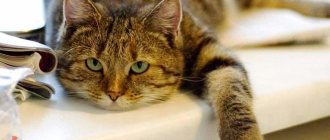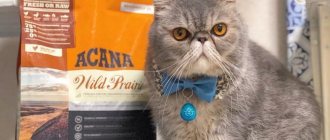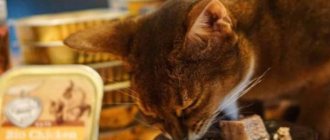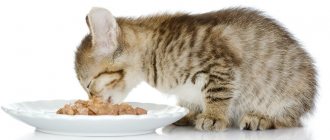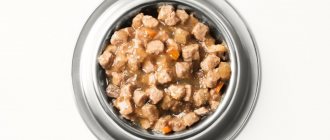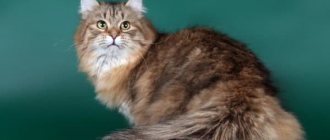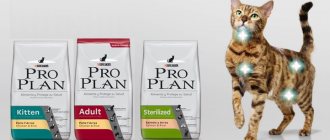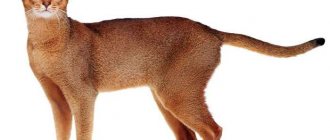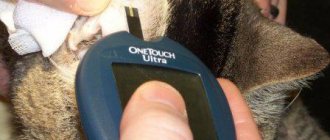Why do sterilized cats need special nutrition?
Sterilization is depriving an animal of the ability to give birth.
If you decide to sterilize a cat, this almost certainly means that during the operation her internal reproductive organs will be removed - the ovaries and uterus, that is, strictly speaking, she will be castrated. What then? Since these organs (mainly the ovaries) produced female sex hormones, which are responsible for many processes in the body, their removal will lead to various consequences.
Estrogens tend to suppress appetite. In addition, sex hormones speed up metabolism. If they stop being produced, the animal’s appetite increases, and at the same time metabolism slows down. As a result, there may be a tendency towards obesity. But not all animals begin to gain weight, and therefore you should not immediately rush to look for food marked “for sterilized”. At this moment, it is much more important for the owner to critically look at the diet and diet that the animal receives; in order for the cat to remain “in shape”, it is necessary, first of all, to monitor the daily food intake and the regime of drinking and movement.
If we talk about how to properly feed neutered cats, then we need to proceed from this conclusion. If previously the animal had a full bowl, from which the cat ate uncontrollably and did not gain excess weight, now she can eat more and ask for more, risking gradually turning into a bun.
Developers of pet food have long created lines of food for sterilized animals: as a rule, they have lower calorie content due to reduced fat content, but in general these diets are not much different from other foods for adult animals.
Wet food overview
Wet food for sterilized cats is suitable for pets with sensitive digestion. It can be given during the recovery period after surgery and as a supplement, a treat; even capricious animals like it. The contents of canned food and spiders contain more moisture than granules - from 70%. This reduces the risk of developing urolithiasis.
However, wet food for sterilized cats is more expensive and more inconvenient to use than dry diets. It quickly weathers, deteriorates, and is less effective at removing plaque from the animal’s teeth. The best option is to combine canned food and granules, giving them to your pet at different feedings.
Animonda Vom Feinsten Castrated Cats Turkey + Tomatoes
Canned food for sterilized cats without chicken and gluten. The basis is dietary turkey meat - an excellent source of protein with high digestibility. A special formula of the vitamin-mineral complex prevents the development of urolithiasis. Due to the absence of ingredients with a high glycemic index, canned food does not lead to weight gain and changes in blood glucose levels.
Features of the food:
- high turkey content - 53% volume;
- the delicate texture of the pate makes canned food suitable for elderly and weakened cats;
- Contains tomatoes - due to their specific smell, canned food may not be suitable for a cat who is picky about food.
Brit "Meat platter with poultry"
Complete nutrition, which contains different types of animal protein - beef, minced chicken, heart, liver. This food for neutered cats contains grains, but does not contain the allergenic corn or wheat. It is suitable for animals with sensitive intestines, as it is enriched with the prebiotic inulin.
Features of the food:
- the composition of microelements and vitamins normalizes the pH level of urine and helps prevent urolithiasis;
- taurine helps maintain cat's heart function;
- It contains fishmeal and fish oil, which improve the quality of wool.
Pro Plan Nutrisavour Sterilized
Spiders with gelled food for sterilized cats. There is little fat in it; part of the meat in the composition is dietary turkey. To extend the active age and maintain the good health of cats, antioxidants are added to canned food - vitamin E and others.
Features of the food:
- low-carb - does not provoke excess weight gain;
- thanks to the patented meat processing technology, canned food has a pleasant taste that pets like;
- The composition contains vegetable proteins, dyes, and fish processing products, so it is advisable to use spiders as a treat and supplement, and not as a complete diet.
Hill's Science Plan Sterilized Cat Young Adult
Turkey pouches in thick sauce can be given to cats aged six months to six years. The diet is suitable for use as a daily, main food for a sterilized cat. It is enriched with vitamins, polyunsaturated acids, L-caritinine and L-lysine, which support optimal metabolism and make the animal energetic.
Features of the food:
- contains vegetable pea protein, which improves intestinal motility;
- low-calorie, helps control weight;
- contains wheat and corn gluten - may cause allergies.
Royal Canin Sterilized
A diet of meat slices in jelly helps maintain bladder health and control weight in cats. Pauchi contain meat and meat products, although they are not detailed. Therefore, it is better to use jelly as a supplement to the main diet.
Features of the food:
- rich vitamin and mineral composition, providing the cat with all the necessary nutrients;
- durable pouch and effective natural preservatives - the product can be stored for a long time;
- contains L-caritinine and lysine, which help burn fat faster and get rid of excess weight.
Monge Grill Sterilized Cat
High-quality Italian food based on veal and lamb does not contain grains and is suitable for cats even with severe allergies. Grill Sterilized Cat Chunky Spiders in Jelly are suitable for animals aged one to six years. The diet is enriched with a complex of nutrients for sterilized cats.
Features of the food:
- contains high-quality animal protein - meat and liver of calves raised in Italy, as well as fish in small quantities;
- raw fiber improves the functioning of the gastrointestinal tract;
- Potatoes and fresh meat increase the nutritional value of the diet - cats eat them well.
Changing your approach to feeding your cat
After sterilizing a pet, owners need to change their views on feeding it. First, you need to limit the amount of food you eat. It is a myth that the bowl should always be filled to the brim, and the cat itself knows how much it needs to eat. Therefore, you need to strictly observe the daily norm, giving it once a day or several feedings during the day. And don’t feel sorry for the little glutton if she “cries” next to an empty bowl. Once given a food reward, your cat will use the same techniques over and over again if he realizes they work.
Secondly, you need to monitor the physical condition of the animal. If the cat receives the recommended portion, and at the same time remains normal, then she has enough. If a standard portion causes weight gain, it must be reduced or the diet changed.
Visually it is not always possible to adequately assess the degree of fatness of an animal, so weighing is optimal. Only constant monitoring by the owners and individual adjustment of the amount of food will allow the cat to stay in shape.
Feeding after surgery
Everything described below does not apply to cats. Males tolerate the operation very easily and immediately after completely recovering from anesthesia return to their normal lifestyle; with females it is a little more difficult. No, you don’t have to sit over an animal for days worrying about its life. After recovery from anesthesia for 2–12 hours, a vest is put on the cat to close the seam.
Several stitches will be placed at the incision site and your task is to monitor their condition. It is important to feed your pet properly during the postoperative period; the cat should not strain during bowel movements. For 3–4 days, feed your pet only soft, low-fat and liquid food:
- Milk, low-fat cream, sugar-free baby formula, grated cottage cheese, natural yogurt, yogurt.
- Lenten broth without salt and meat.
- Raw or boiled and ground egg.
- Special canned food for cats that have recovered from illness or surgery are most often marked. The advantage is a clear calculation of the animal’s weight, an optimal balance of proteins, fats and carbohydrates, enrichment with vitamins, immunostimulating components and microelements. Possible disadvantages are intolerance to preservatives and high price.
How to properly feed a cat after sterilization when gaining weight: changing the diet
The first thing you need to do when gaining weight is to reduce your calorie intake through the following options:
- reduce the amount of carbohydrates as much as possible - look at the composition of the food and replace the product if it contains a lot of grains, potatoes or legumes (the less grains and starchy foods the cat gets from the food, the better);
- reduction in fat levels - look at the fat content in the guaranteed analysis; for cats that are prone to obesity or are overweight, it is advisable that its level should not exceed 15%;
- ensuring sufficient mobility - play with your cat a lot, give her interesting toys so that she can move as much as possible.
It should be noted that reducing calorie content does not mean reducing the quality of feed. It is extremely important for a cat to receive high-quality sources of fat and protein, so diets in which full-fledged animal fat is replaced with vegetable oil, and meat with sources of vegetable protein, are not suitable for her in any case.
Products harmful and hazardous to health
So that the nutrition of a sterilized cat is as healthy as possible and does not cause harm to the animal.
River fish
The following foods should be excluded from the diet:
- River fish, because it contains many bones that are dangerous to the internal organs of the animal.
- Fatty dairy products (above 10%).
- Oatmeal because it has too high a percentage of magnesium.
- Legumes and vegetables with high starch content. Potatoes can upset a neutered cat's stomach and cause rapid weight gain.
- Semolina porridge is not a healthy product because it has no nutritional properties and contains too many carbohydrates.
Smoked, fried, salted and pickled foods are also prohibited.
Feeding dry food to sterilized cats with different activity levels
In apartment cats, energy expenditure can be very low, but it’s another matter when the question arises of how to properly feed a sterilized cat that has the opportunity to walk. Theoretically, such a cat's energy expenditure will be much higher, but it is unlikely to begin to gain excess weight.
But here it is important to take into account such a moment as hunting. If a cat actively catches mice during walks, then it can almost completely satisfy its nutritional needs through its natural diet. However, many domestic cats only play with their prey, losing interest in it after death or bringing it to the owners to “boast of success”, in which case she regularly visits her bowl, and you should monitor the amount of food eaten, and the owner needs to monitor his weight animal and independently choose the optimal feeding option. If the cat gains weight on a standard portion of food, you need to give less food. If the animal runs around a lot, does not eat its prey and begins to lose weight, it may have to be given a little more food (the norm for active animals is the maximum values in the table indicated on the package).
It is advisable to resolve the issue of nutrition before the procedure.
The first day after sterilization should not be filled with large meals; it is better to give the cat plenty of fluids to remove anesthesia and anesthetics. Next, offer small portions of food, assessing the body’s further reaction to it. Usually 2 feedings are sufficient.
You need to pour or put in small portions. The main thing, especially when using dry food, is to fill the bowl with clean water, changing it every day at intervals of 1-2 (winter) and 3-4 times (summer season). It is important not to overfeed your pet; increased weight negatively affects the condition of the mucous membrane and coat, and contributes to the occurrence of urolithiasis. The work of the heart deteriorates, the vessels become inelastic and clogged.
When choosing to feed cats from natural products at home, you should consider important nuances:
- Keep your diet balanced; you must include a complex of vitamins and minerals. In nurseries or clinics, bone meal is used to strengthen the skeleton, and sulfur is used for wool quality.
- All food should be given slightly warm or at room temperature.
- Only freshly prepared food. The leftovers are not stored in a bowl; it is better to throw them away (chapping and rotting).
- Follow a dietary regime with a low-calorie diet and a full amount - so that the cat does not gain weight, but remains active and healthy. It is advisable to take professional advice from a veterinarian to calculate the sufficient volume; it is difficult to do such a calculation yourself. Sometimes the packages of ready-made coma contain recommendations regarding servings in grams - follow them.
- The nature of a predator requires meat, preference is given to turkey or chicken. Rarely (1-2 times a week) allow sea fish (river contains parasites and heavy metals) and beef.
A boiled chicken egg will also be useful; a raw one can “provide” your pet with salmonellosis. You need to pour or put in small portions
- The inclusion of fermented unsweetened and low-fat products (cottage cheese, kefir, fermented baked milk, yogurt) - adults do not need milk, it is even harmful.
- Use carbohydrates in your diet; buckwheat, rice, and wheat cereals are suitable. “My cat is a fan of barley porridge,” writes the owner of the Sphynx. At the same time, semolina is not recommended due to the small amount of useful elements in it and complex processing during the manufacturing process. Barley porridge contributes to constipation.
- Sometimes add by-products to the weekly menu - liver (remember that its properties are to accumulate heavy metals), hearts, stomachs. Be sure to boil before use. Do not give raw meat to your pets (worms and protein intoxication); freeze it or bring it in boiling water until half cooked, then feed the cat.
- Vegetable oil (any oil, not just olive oil), fish oil in capsules help improve the functioning of the excretory system, prevent constipation, and normalize metabolic processes. There is some fat in chicken skin, but its amount does not cover the minimum dose in the diet.
- Healthy and tasty treats for a sterilized cat are fruits; preference should be given to seasonal apples, peeled from seeds and skin.
Sterilization is not to blame
Sterilization is the right way to prolong a pet’s life and improve its quality. But health largely depends on proper feeding. No matter how “cute” a chubby cat may look, don’t forget that this is the beginning of a serious problem. Such an animal will not be able to lead an active lifestyle and play, and runs the risk of becoming obese, developing diabetes, and problems with joints, heart, kidneys, and liver.
It is not the food or the operation itself that is to blame for obesity - the responsibility lies primarily with the owners, so it is better not to neglect the advice of our veterinarians on how to properly feed a sterilized cat.
Feed your cat correctly after castration, and you will not notice any changes in her behavior or appearance. She will be as active, playful and healthy as before.
Diet preparation
A properly composed diet is an opportunity to prevent urolithiasis and obesity.
In the first days, portions should be a third of the usual dose.
The cause of the disease may be an excess of:
- Vitamin A (found in cheese, liver, butter).
- Glutamic acid (found in seafood, fish, tomatoes).
- Magnesium (found in nuts, beans, chocolate).
- Phosphorus (found in eggs, fish, peas, corn).
The daily amount of feed should be 30-60 g per 1 kg of animal.
The daily norm contains:
- 35% protein. The animal's body does not produce it on its own.
- 35% carbohydrates, important for maintaining energy.
- 30% fat. Their deficiency contributes to the appearance of problems with the skin and coat, while an excess leads to excess weight gain.
Be sure to read:
Can cats eat fish: how much can you give, what are the benefits and harms, what is not allowed, combination with food
You cannot mix natural food and industrial feed.
